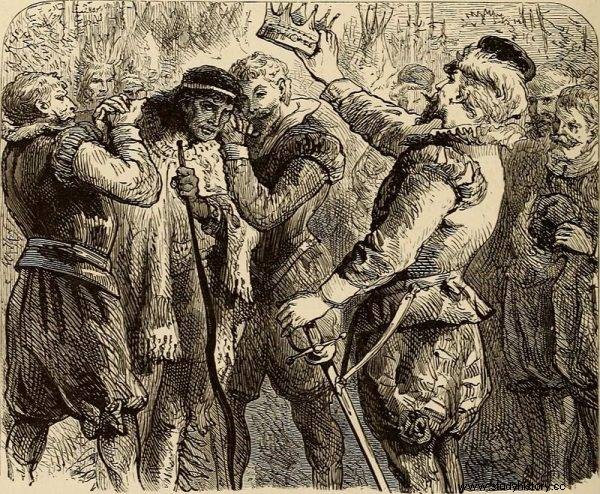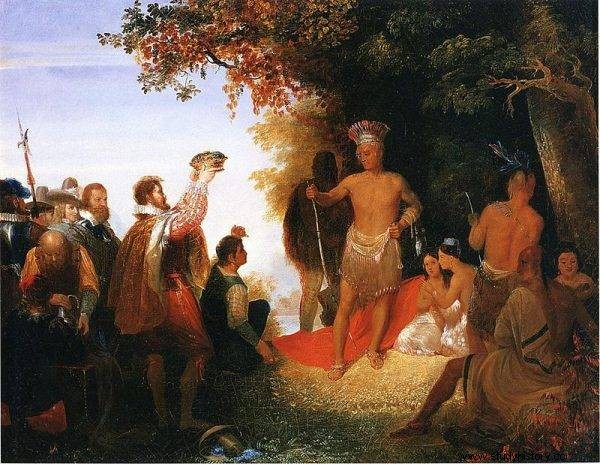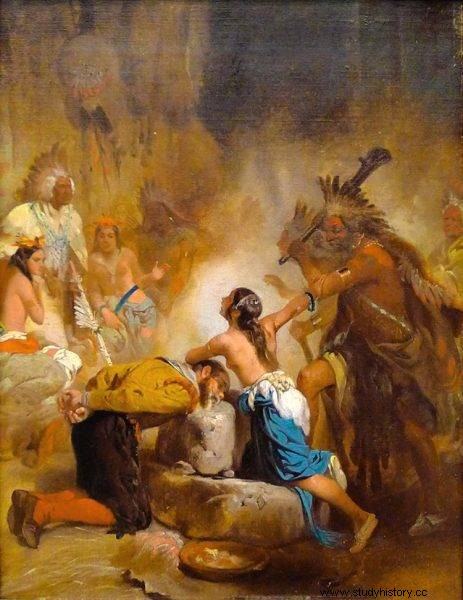We know the character of the Indian chief Powhatan from the Disney cartoon film. Who was the archetypal Indian father of beautiful Pocahontas? And what was his meeting with John Smith really like?
At the beginning of the 17th century, the English followed the Spaniards to conquer America. Eager to establish a new colony and wrest a piece of the virgin Indian world for himself, King James I Stuart sent a group of pioneers to the site. Jill Lepore in "We, the Nation" describes:
In 1606 he issued a charter giving a group of people the right to settle in "the part of America commonly known as Virginia", which he considered his own because [...] lands these "were not owned by any Christian ruler or people" and the natives "lived in darkness", which meant they did not know Christ.

Powhatan's Coronation
The aborigines, of course, were not asked for their views on this imposed sovereignty. While the English were going to adopt the tactic of settlement (instead of conquest like the Spaniards), while trying to convert as many natives as possible to one true faith, in the end ... it turned out as usual.
Problems at startup
When he boarded a ship for America in 1606, John Smith had only twenty-six springs on his neck. Despite this, he managed to gain experience in the fight against the Spaniards and Turks, as well as being taken into captivity and escaping from it. He was tempted by the prospect of a journey to unknown lands, where the English recruited by the Virginia Company planned to establish the Jamestown colony. It soon turned out, however, that the young soldier was one of the more competent conquerors of the new land ...
According to a secret letter locked in a chest on the ship, John Smith was elected governor. The envelope was unsealed only after being nailed to the shore. It turned out, however, that Smith had to rule an extremely lazy community. Not only that, instead of dealing with honest work, they immediately began to come into conflict with the local population, there were hardly any professionals among them yet . According to the accounts of the governor himself, only one carpenter and two blacksmiths sailed across the ocean. Besides, the English colony was inhabited by "ladies, traders, soldiers, libertines and the like."
Changing clothes
Undaunted, John Smith forbade those who did not work from eating and took up diplomacy to save an already damaged relationship with the Indians. The colony was in the territory of Chief Powhatan, who ruled over the surrounding tribes at the time.
As part of a diplomatic act, the governor organized the coronation ceremony of the Indian chief, during which he presented him with a scarlet cloak sent by King James. Probably in return, Powhatan gave Smith his own coat, which was also a map of his territory. This is what Jill Lepore describes the gift:
They trimmed deer with knives made of stone and stripped flesh and fat off the skin with a rib. They soaked the skins in ashes and grain mash and stretched them over frames made of sticks and sewed them together with twine made of twisted tendons.
They sewed hundreds of small coastal snail shells, emptied and dried, onto the sewn and dyed skins, embroidering human figures surrounded by a white tailed deer and a mountain lion on a field of 34 circles. The man was their ruler, the animals his spirits, and the circles signified the villages he ruled over. […] Perhaps he used deer hide as a cloak; perhaps it was used to honor his ancestors. […]
In 1638 an Englishman saw her at an English museum and called the stitched tendon twine deer skin "the cloak of the King of Virginia". It was Powhatan's cloak, however, and it also served as a map of his lordship.
Great leader
Not knowing the language, Powhatan might not understand much of the ceremony. What did the act of changing clothes really mean to him? We'll never know. We do know that the leadership of the Indians in his sphere of influence was for Powhatan an origin and leadership acquired thing, not received from an overseas king at his coronation.
Historians estimate that a man named Wahunsunacock was born in 1547. He inherited from his father sovereignty over several tribes near the present-day city of Richmond. According to the most probable assumptions, in various ways he extended his sphere of influence to about thirty tribes, that is, from ten to fifteen thousand people in total. The English called him Powhatan, which was basically the Indian name for his native settlement on the James River.

In return for the "coronation" Powhatan gave John Smith his coat
In 1607, John Smith, captured while hunting by Wahunsunacock's younger brother, Opchanacanough, was brought before the Indian. According to the Englishman's account, written only in 1624, the chieftain's daughter prevented him from harming the newcomer. It is not hard to guess that today we know this daughter as Pocahontas, although her real name was Matoaka.
Some researchers argue that there was a misunderstanding, and Powhatan did not want to kill Smith - he was only supposed to perform a disturbing-looking rite of admitting the white man to the united tribes. It seems that the story of "King of America" consists mainly of similar misconceptions ...
Royal Heritage
In 1609, John Smith left America, sent back by disgruntled colonists. The "poor people" were forced to work by him, and without the governor's whip over their heads, they could devote themselves entirely to robbing the Indians. The war quickly broke out, which in 1613 was stopped for some time by the marriage of John Rolfe from Pocahontas . According to some premises, the couple was actually supposed to have mutual affection, and the chief's daughter willingly succumbed to assimilation into the new culture and religion. The woman was given the Christian name Rebecca.

Pocahontas saves John Smith
Unfortunately, peace did not last long. Powhatan died in 1618, leaving power to his successors, the younger brothers Optichapam and Opchanacanough. The latter took the initiative, trying at all costs to expel the invaders from Virginia. In 1622, he organized the famous Jamestown massacre, during which the Indians murdered 347 colonists and destroyed 70 settlements.
In 1635, Thomas Rolfe, son of Pocahontas, returned to his homeland. His descendants are counted among the First Families of Virginia, combining European and Indian blood. Members of the Mattaponi and Patawomeck tribes claim that Powhatan's genes also survived through Ka-Okee, Pocahontas daughter from her first marriage.
